stop start MITSUBISHI SHOGUN 2008 Owner's Manual (in English)
[x] Cancel search | Manufacturer: MITSUBISHI, Model Year: 2008, Model line: SHOGUN, Model: MITSUBISHI SHOGUN 2008Pages: 538, PDF Size: 25.09 MB
Page 86 of 538
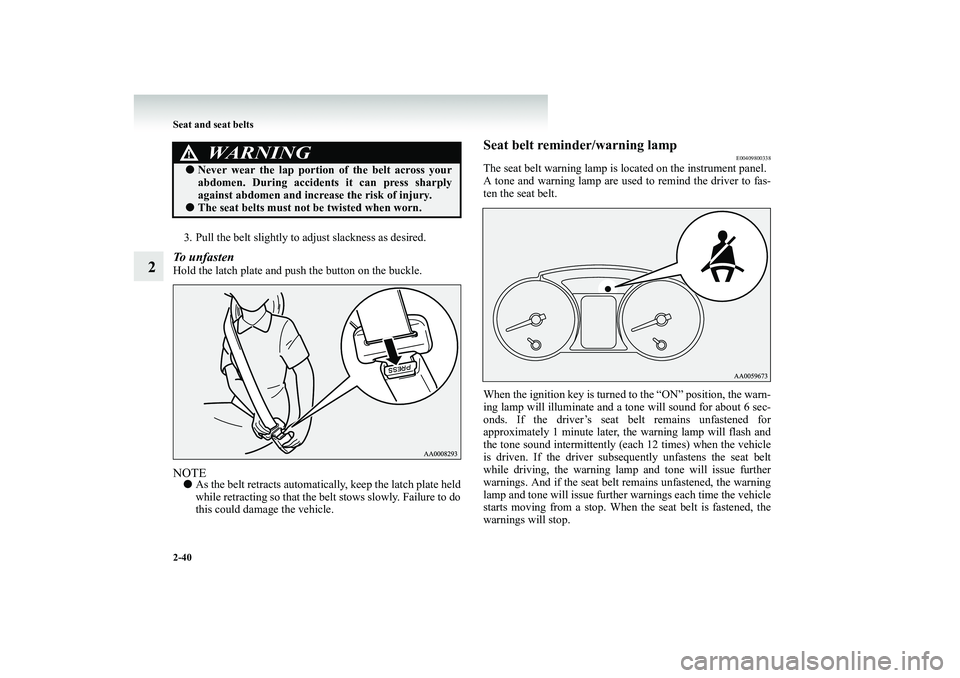
2-40 Seat and seat belts
2
3. Pull the belt slightly to adjust slackness as desired.To unfasten Hold the latch plate and pu
sh the button on the buckle.
NOTEâ—Ź
As the belt retracts automatically, keep the latch plate held while retracting so that the belt stows slowly. Failure to dothis could damage the vehicle.
Seat belt reminder/warning lamp
E00409800338
The seat belt warning lamp is located on the instrument panel.A tone and warning lamp are used to remind the driver to fas- ten the seat belt. When the ignition key is turned to the “ON” position, the warn- ing lamp will illuminate and a tone will sound for about 6 sec- onds. If the driver’s seat belt remains unfastened for approximately 1 minute later, the warning lamp will flash andthe tone sound intermittently (each 12 times) when the vehicle is driven. If the driver subseq
uently unfastens the seat belt
while driving, the warning lamp and tone will issue furtherwarnings. And if the seat belt remains unfastened, the warning lamp and tone will issue further
warnings each time the vehicle
starts moving from a stop. When
the seat belt is fastened, the
warnings will stop.
WARNING
!â—Ź
Never wear the lap portio
n of the belt across your
abdomen. During accident
s it can press sharply
against abdomen and increa
se the risk of injury.
â—Ź
The seat belts must not be twisted when worn.
BK-BK2008E1ENUK.en-uk-Section5.fm Page
40 Wednesday, January 9, 2008 4:28 PM
Page 137 of 538
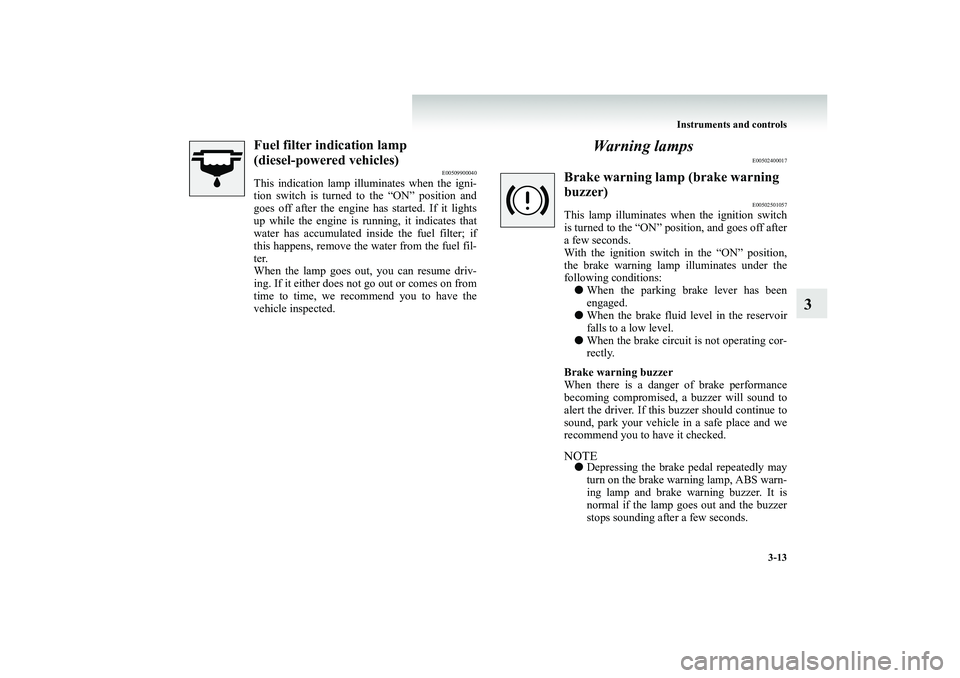
Instruments and controls
3-13
3
Fuel filter indication lamp (diesel-powered vehicles)
E00509900040
This indication lamp illuminates when the igni- tion switch is turned to the “ON” position andgoes off after the engine has started. If it lights up while the engine is ru
nning, it indicates that
water has accumulated inside the fuel filter; ifthis happens, remove the
water from the fuel fil-
ter. When the lamp goes out, you can resume driv-ing. If it either does not go out or comes on from time to time, we recommend you to have the vehicle inspected.
Wa r n i n g l a m p s
E00502400017
Brake warning lamp (brake warning buzzer)
E00502501057
This lamp illuminates when the ignition switch is turned to the “ON” position, and goes off after a few seconds.With the ignition switch in the “ON” position, the brake warning lamp illuminates under the following conditions:●
When the parking brake lever has been engaged.
â—Ź
When the brake fluid level in the reservoir falls to a low level.
â—Ź
When the brake circuit
is not operating cor-
rectly.
Brake warning buzzer When there is a danger of brake performance becoming compromised,
a buzzer will sound to
alert the driver. If this
buzzer should continue to
sound, park your vehicl
e in a safe place and we
recommend you to have it checked.NOTEâ—Ź
Depressing the brake pe
dal repeatedly may
turn on the brake warning lamp, ABS warn- ing lamp and brake
warning buzzer. It is
normal if the lamp goes out and the buzzer stops sounding after a few seconds.
BK-BK2008E1ENUK.en-uk-Section6.fm Page
13 Wednesday, January 9, 2008 4:32 PM
Page 138 of 538
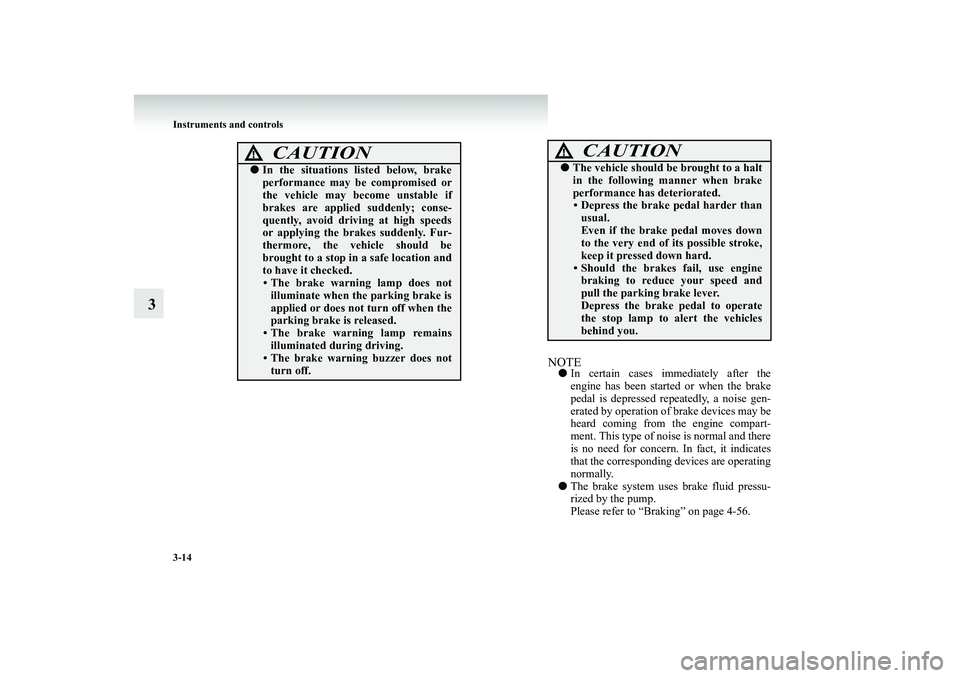
3-14 Instruments and controls
3
NOTEâ—Ź
In certain cases immediately after the engine has been started or when the brake pedal is depressed repeatedly, a noise gen- erated by operation of brake devices may beheard coming from
the engine compart-
ment. This type of noise is normal and there is no need for concer
n. In fact, it indicates
that the corresponding devices are operating normally.
â—Ź
The brake system uses
brake fluid pressu-
rized by the pump. Please refer to “Braking” on page 4-56.
CAUTION
!â—Ź
In the situations listed below, brake performance may be compromised orthe vehicle may become unstable if brakes are applied suddenly; conse- quently, avoid driving at high speedsor applying the brakes suddenly. Fur- thermore, the vehicle should be brought to a stop in a safe location andto have it checked.• The brake warning lamp does notilluminate when the parking brake is applied or does not turn off when the parking brake is released.• The brake warning lamp remains illuminated during driving. • The brake warning buzzer does notturn off.
â—Ź
The vehicle should be brought to a halt in the following manner when brake performance has deteriorated.• Depress the brake pedal harder than usual. Even if the brake pedal moves downto the very end of its possible stroke, keep it pressed down hard. • Should the brakes fail, use enginebraking to reduce your speed and pull the parking brake lever. Depress the brake pedal to operate the stop lamp to
alert the vehicles
behind you.CAUTION
!
BK-BK2008E1ENUK.en-uk-Section6.fm Page
14 Wednesday, January 9, 2008 4:32 PM
Page 204 of 538
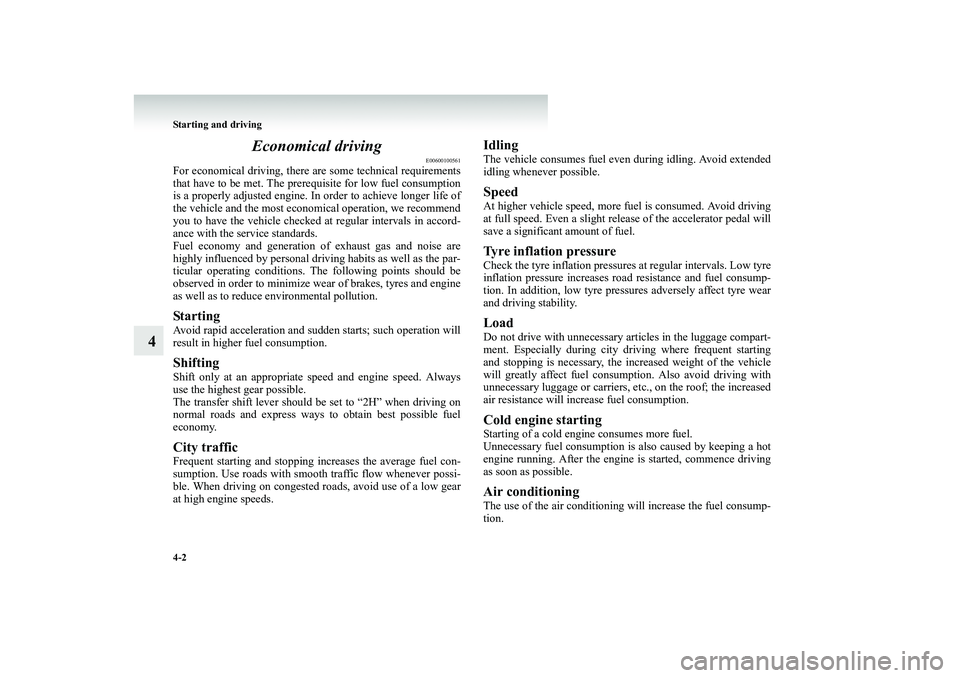
4-2 Starting and driving
4
Economical driving
E00600100561
For economical driving, there ar
e some technical requirements
that have to be met. The prerequisite for low fuel consumption is a properly adjusted engine. In order to achieve longer life ofthe vehicle and the most econo
mical operation, we recommend
you to have the vehicle checked
at regular intervals in accord-
ance with the service standards.Fuel economy and generation of exhaust gas and noise are highly influenced by personal driving habits as well as the par- ticular operating conditions. The following points should beobserved in order to minimize w
ear of brakes, tyres and engine
as well as to reduce environmental pollution.StartingAvoid rapid acceleration and sudden starts; such operation will result in higher fuel consumption.ShiftingShift only at an appropriate
speed and engine speed. Always
use the highest gear possible. The transfer shift lever should be set to “2H” when driving on normal roads and express ways to obtain best possible fueleconomy.City trafficFrequent starting and stopping
increases the average fuel con-
sumption. Use roads with smooth
traffic flow whenever possi-
ble. When driving on congested
roads, avoid use of a low gear
at high engine speeds.
IdlingThe vehicle consumes fuel even during idling. Avoid extended idling whenever possible.SpeedAt higher vehicle speed, more fu
el is consumed. Avoid driving
at full speed. Even a slight re
lease of the accelerator pedal will
save a significant amount of fuel.Tyre inflation pressureCheck the tyre inflation pressure
s at regular intervals. Low tyre
inflation pressure increases ro
ad resistance and fuel consump-
tion. In addition, low tyre pres
sures adversely affect tyre wear
and driving stability.LoadDo not drive with unnecessary articles in the luggage compart- ment. Especially during city dr
iving where frequent starting
and stopping is necessary, the increased weight of the vehicle will greatly affect fuel consumption. Also avoid driving with unnecessary luggage or carriers,
etc., on the roof; the increased
air resistance will increase fuel consumption.Cold engine startingStarting of a cold engine consumes more fuel. Unnecessary fuel consumption
is also caused by keeping a hot
engine running. After the engine is started, commence driving as soon as possible.Air conditioningThe use of the air conditioning
will increase the fuel consump-
tion.
BK-BK2008E1ENUK.en-uk-Section7.fm Page 2 Wednesday, January 9, 2008 4:36 PM
Page 208 of 538

4-6 Starting and driving
4
Parking brake
E00600500422
To park the vehicle, first bring it to a complete stop, fully apply the parking brake lever sufficiently to hold the vehicle.To apply the parking brakeNOTEâ—Ź
Apply sufficient force to the parking brake lever to hold the vehicle stationary after
the foot brake is released.
â—Ź
If the parking brake does not hold the vehicle stationary after the foot brake is releas
ed, have your vehicle checked
immediately.
To release the parking brake
1- Pull the lever up without pushing the button at the end of
hand grip.
1- Pull the lever up slightly. 2- Push the button at the end of hand grip. 3- Push the lever downward.
BK-BK2008E1ENUK.en-uk-Section7.fm Page 6 Wednesday, January 9, 2008 4:36 PM
Page 209 of 538
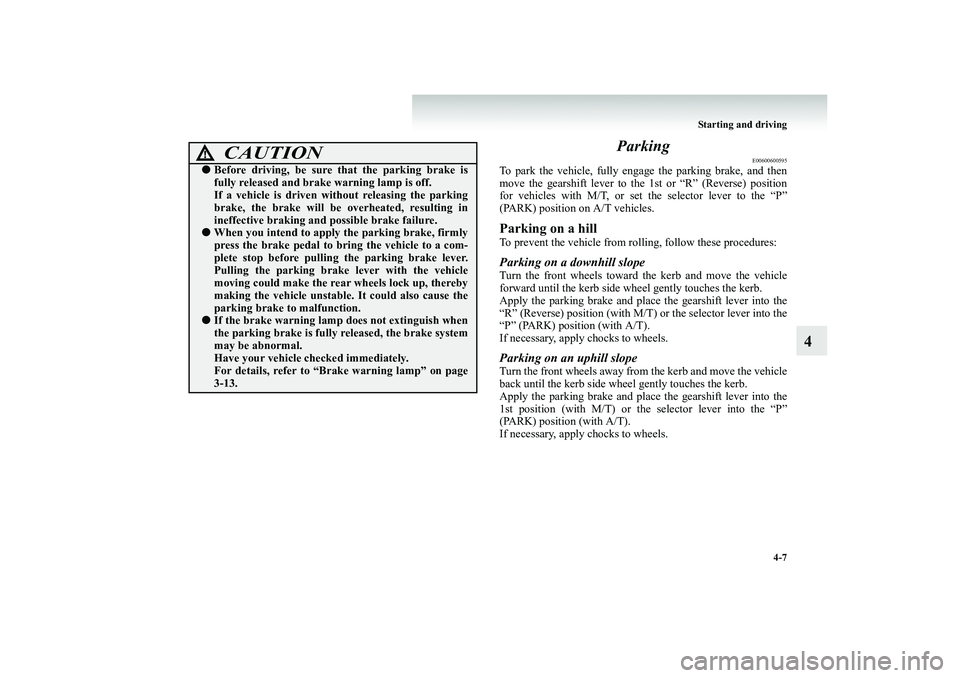
Starting and driving
4-7
4
Parking
E00600600595
To park the vehicle, fully enga
ge the parking
brake, and then
move the gearshift lever to th
e 1st or “R” (Reverse) position
for vehicles with M/T, or set
the selector lever to the “P”
(PARK) position on A/T vehicles.Parking on a hillTo prevent the vehicle from rolling, follow these procedures:Parking on a downhill slopeTurn the front wheels toward the kerb and move the vehicleforward until the kerb side wheel gently touches the kerb.Apply the parking brake and place
the gearshift lever into the
“R” (Reverse) position (with M/T) or the selector lever into the “P” (PARK) position (with A/T).If necessary, apply chocks to wheels.Parking on an uphill slopeTurn the front wheels away from
the kerb and move the vehicle
back until the kerb side wheel gently touches the kerb.Apply the parking brake and place
the gearshift lever into the
1st position (with M/T) or the selector lever into the “P” (PARK) position (with A/T).If necessary, apply chocks to wheels.
CAUTION
!â—Ź
Before driving, be sure that the parking brake is fully released and brake warning lamp is off.If a vehicle is driven wi
thout releasing the parking
brake, the brake will be
overheated, resulting in
ineffective brak
ing and possible brake failure.
â—Ź
When you intend to apply
the parking brake, firmly
press the brake pedal to bring the vehicle to a com- plete stop before pullin
g the parking brake lever.
Pulling the parking brake
lever with the vehicle
moving could make the rear
wheels lock up, thereby
making the vehicle unstable.
It could also cause the
parking brake to malfunction.
â—Ź
If the brake warning lamp
does not extinguish when
the parking brake is fully released, the brake system may be abnormal. Have your vehicle checked immediately.For details, refer to “Bra
ke warning lamp” on page
3-13.
BK-BK2008E1ENUK.en-uk-Section7.fm Page 7 Wednesday, January 9, 2008 4:36 PM
Page 215 of 538
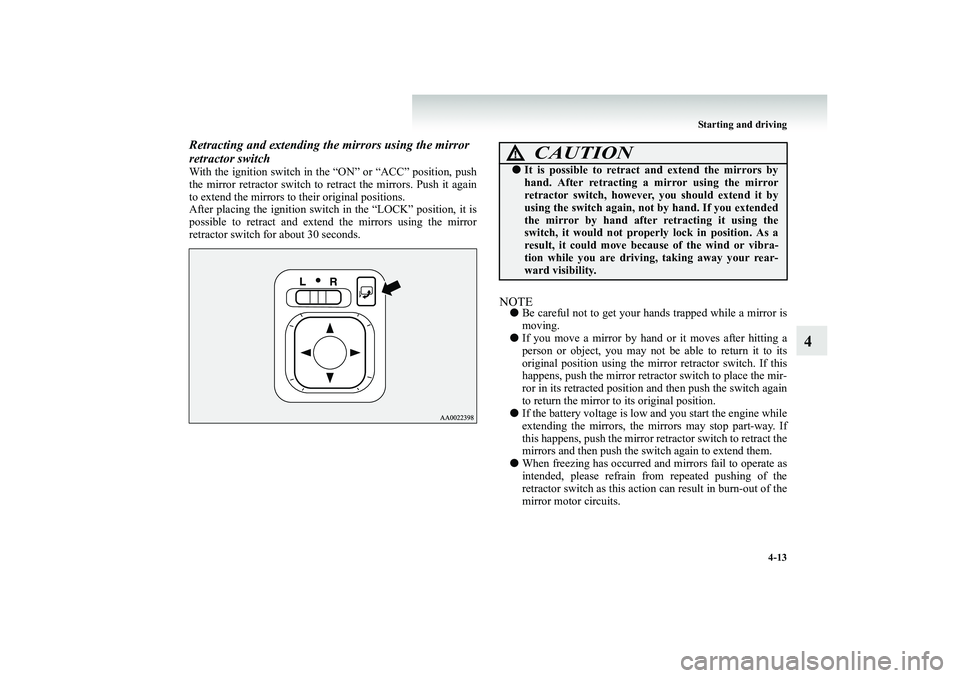
Starting and driving
4-13
4
Retracting and extending the mirrors using the mirror retractor switchWith the ignition switch in the “ON” or “ACC” position, push the mirror retractor switch to retract the mirrors. Push it again to extend the mirrors to their original positions. After placing the ignition switch in the “LOCK” position, it ispossible to retract and extend the mirrors using the mirror retractor switch for about 30 seconds.
NOTEâ—Ź
Be careful not to get your hands trapped while a mirror is moving.
â—Ź
If you move a mirror by hand or it moves after hitting a person or object, you may not be able to return it to its original position using the mirr
or retractor switch. If this
happens, push the mirror retract
or switch to place the mir-
ror in its retracted position a
nd then push the switch again
to return the mirror to its original position.
â—Ź
If the battery voltage is low
and you start the engine while
extending the mirrors, the mirrors may stop part-way. If this happens, push the mirror retractor switch to retract themirrors and then push the switch again to extend them.
â—Ź
When freezing has occurred an
d mirrors fail to operate as
intended, please refrain from repeated pushing of theretractor switch as this action
can result in burn-out of the
mirror motor circuits.
CAUTION
!â—Ź
It is possible to retract and extend the mirrors by hand. After retracting a mirror using the mirrorretractor switch, however, you should extend it by using the switch again, not by hand. If you extended the mirror by hand after retracting it using theswitch, it would not properly lock in position. As a result, it could move beca
use of the wind or vibra-
tion while you are driving, taking away your rear-ward visibility.
BK-BK2008E1ENUK.en-uk-Section7.fm Page
13 Wednesday, January 9, 2008 4:36 PM
Page 216 of 538

4-14 Starting and driving
4
Automatic extension of mirrorsIf the engine is stopped and st
arted with the mirrors retracted,
the mirrors automatically extend
for safety when the vehicle
speed reaches 30 km/h (19 mph).Heated mirror*
E00601200312
To demist or defrost the outside rear-view mirrors, press the rear window demister switch. The indication lamp (C) will illuminate while the demister is on.The heater will be turned off automatically in about 20 minutes.
Ignition switch
E00601400822
LOCKThe engine is stopped and the steering wheel locked. The keycan only be inserted and removed in this position.ACCThe engine is stopped, but the
electrical devices such as the
radio and cigarette lighter can be operated.ONThe engine is running, and al
l the vehicle’s electrical devices
can be operated.STARTThe starter motor operates. After
the engine has started, release
the key and it will automatically return to the “ON” position.Vehicles with M/T Vehicles with A/T
BK-BK2008E1ENUK.en-uk-Section7.fm Page
14 Wednesday, January 9, 2008 4:36 PM
Page 219 of 538

Starting and driving
4-17
4
For vehicles with an A/T, when
removing the key, first set the
selector lever to the “P” (PARK) position, and then turn the key to the “LOCK” position, and remove it.Vehicles with A/T
CAUTION
!â—Ź
Do not remove the ignition key from the ignition switch while driving.
The steering wheel will be
locked, causing loss of control.
â—Ź
If the engine is stopped wh
ile driving, the brake ser-
vomechanism will cease to function and brakingefficiency will deteriorat
e. Also, the power steering
system will not function and it will require greater manual effort to op
erate the steering.
â—Ź
Do not leave the key in the “ON” position for a long time when the engine is not running, doing so will cause the battery to be discharged.
â—Ź
Do not turn the key to the “START” position when the engine is running, doing so could damage thestarter motor.
BK-BK2008E1ENUK.en-uk-Section7.fm Page
17 Wednesday, January 9, 2008 4:36 PM
Page 220 of 538
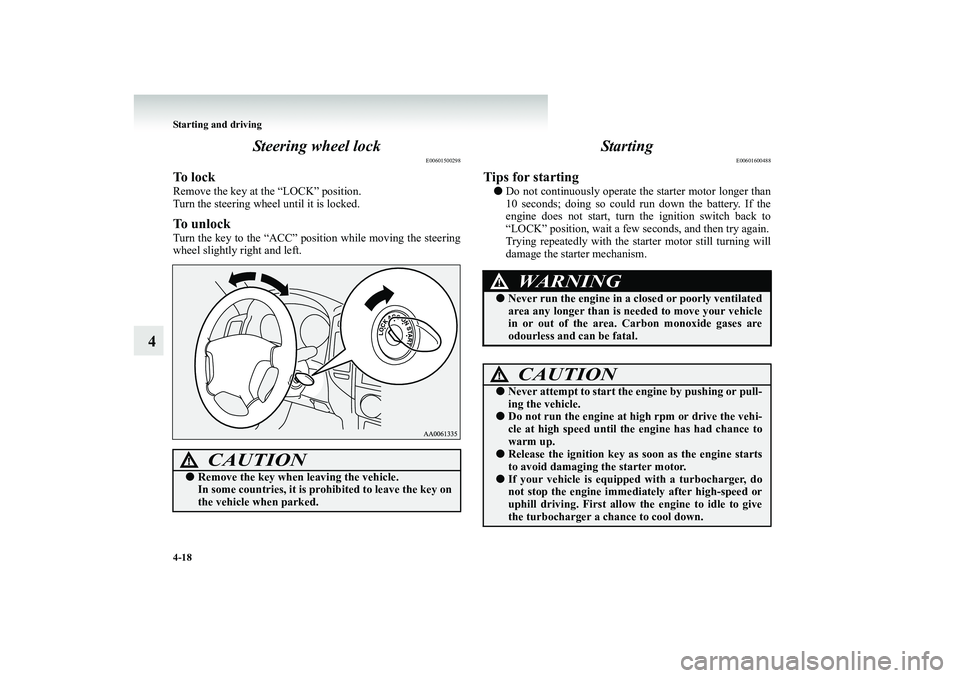
4-18 Starting and driving
4
Steering wheel lock
E00601500298
To l o c kRemove the key at the “LOCK” position. Turn the steering wheel until it is locked.To unlockTurn the key to the “ACC” position while moving the steering wheel slightly right and left.
Starting
E00601600488
Tips for startingâ—Ź
Do not continuously operate the starter motor longer than 10 seconds; doing so could run down the battery. If the engine does not start, turn the ignition switch back to“LOCK” position, wait a few seconds, and then try again. Trying repeatedly with the starter motor still turning will damage the starter mechanism.
CAUTION
!â—Ź
Remove the key when leaving the vehicle. In some countries, it is pr
ohibited to leave the key on
the vehicle when parked.
WARNING
!â—Ź
Never run the engine in a cl
osed or poorly ventilated
area any longer than is needed to move your vehiclein or out of the area. Carbon monoxide gases are odourless and can be fatal.CAUTION
!â—Ź
Never attempt to start the engine by pushing or pull- ing the vehicle.
â—Ź
Do not run the engine at hi
gh rpm or drive the vehi-
cle at high speed until th
e engine has had chance to
warm up.
â—Ź
Release the ignition key as
soon as the engine starts
to avoid damaging the starter motor.
â—Ź
If your vehicle is equipp
ed with a turbocharger, do
not stop the engine immedi
ately after high-speed or
uphill driving. First allow the engine to idle to give the turbocharger a chance to cool down.
BK-BK2008E1ENUK.en-uk-Section7.fm Page
18 Wednesday, January 9, 2008 4:36 PM